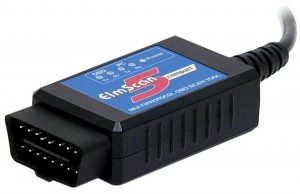 On-Board Diagnostics (OBD) is a generic term referring to a vehicle’s self-diagnostic and reporting capability. Through a port, it provides realtime data in addition to a standardized series of diagnostic trouble codes (DTC), which allow one to rapidly identify and remedy malfunctions within the vehicle. OBD-II is simply an improvement over OBD-I in both capability and standardization.
On-Board Diagnostics (OBD) is a generic term referring to a vehicle’s self-diagnostic and reporting capability. Through a port, it provides realtime data in addition to a standardized series of diagnostic trouble codes (DTC), which allow one to rapidly identify and remedy malfunctions within the vehicle. OBD-II is simply an improvement over OBD-I in both capability and standardization.
I got the reasonably priced ElmScan 5 Compact OBD-II Scan Tool because I wanted to have the capability to read vehicle data as well as clear DTCs. I also wanted to get the ECU Calibration ID (don’t ask me why). As it’s name indicates, it is a compact tool measuring about the size of a pack of cigarettes. It has a reasonably long USB cable but you may want to have an OBD-II extension cable. The OBD-II port is usually under the dash on the driver’s side and it can get in the way of your legs.
It comes with drivers and a free OBDWiz SOftware. But it is best if you get the latest from FTDI and ScanTool.net. For the Windows 2000 drivers, do not follow the instructions provided. Instead, plug in the ElmScan 5 to your laptop and wait until Windows detects the device and then asks your for the location of the drivers. This will save you a lot of headaches. OBDWiz is more straightforward to install but you probably will want to get a more featured software anyway.